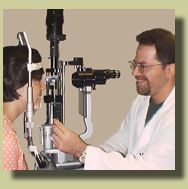|
THE FIRST YEAR
 Following
the introductory course, residents begin a series of five 10-week rotations
in the first year. Two of these rotations are spent at University
Hospital: one involves staffing the General Eye Clinic
and the second involves staffing each of the subspecialty clinics. In
the General Eye Clinic, the first-year resident is responsible for day-to-day
management of the inpatient and consult service as well as examination
of all emergency patients. In contrast, the subspecialty first-year
resident rotates each week through each of 6 different subspecialty
clinics: retina, cornea, neuro-ophthalmology, low vision,
contact lens, and uveitis. Additionally, the subspecialty first-year
resident spends 3 full days per month in the Ophthalmic Pathology Department at Wills Eye Hospital, reviewing
ocular histopathology slides from their extensive slide collection as
well as current pathology specimens obtained during surgery. The subspecialty experience provides early exposure to the management
of a varity of problems, both common and complex, in each of the ophthalmic
disciplines. In both the general eye and subspecialty clinics, first-year
residents are continually mentored by both attending physicians and
more senior residents. Following
the introductory course, residents begin a series of five 10-week rotations
in the first year. Two of these rotations are spent at University
Hospital: one involves staffing the General Eye Clinic
and the second involves staffing each of the subspecialty clinics. In
the General Eye Clinic, the first-year resident is responsible for day-to-day
management of the inpatient and consult service as well as examination
of all emergency patients. In contrast, the subspecialty first-year
resident rotates each week through each of 6 different subspecialty
clinics: retina, cornea, neuro-ophthalmology, low vision,
contact lens, and uveitis. Additionally, the subspecialty first-year
resident spends 3 full days per month in the Ophthalmic Pathology Department at Wills Eye Hospital, reviewing
ocular histopathology slides from their extensive slide collection as
well as current pathology specimens obtained during surgery. The subspecialty experience provides early exposure to the management
of a varity of problems, both common and complex, in each of the ophthalmic
disciplines. In both the general eye and subspecialty clinics, first-year
residents are continually mentored by both attending physicians and
more senior residents.
Of the 3 remaining first-year rotations, 2 are spent at the Veterans
Affairs Medical Center
and 1 at the Jersey
City Medical Center. Each of these rotations provides opportunities
for first-year residents to begin assisting in intraocular surgeries.
Following an introductory microsurgery course held early in the year
(see below), first-year residents begin performing their first cataract
extractions at these affiliated hospitals. By the end of the first year,
residents will have performed at least 5 intraocular surgeries and assisted
in several dozen others.
First-year residents provide a major portion of the Institute’s inpatient
care and perform physical and ocular examinations on patients in the clinic
as well as private patients. |

![]()
 Following
the introductory course, residents begin a series of five 10-week rotations
in the first year. Two of these rotations are spent at
Following
the introductory course, residents begin a series of five 10-week rotations
in the first year. Two of these rotations are spent at